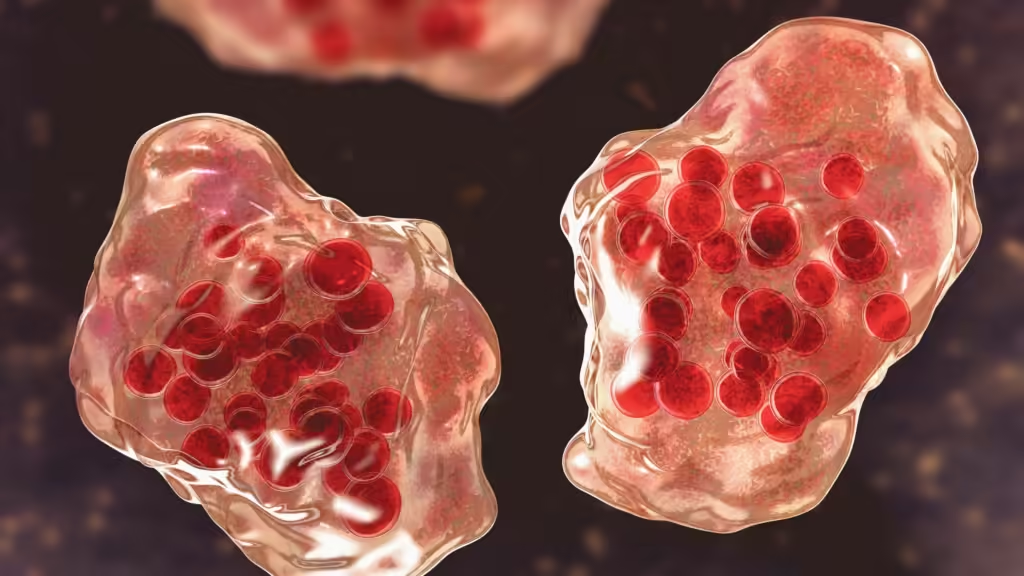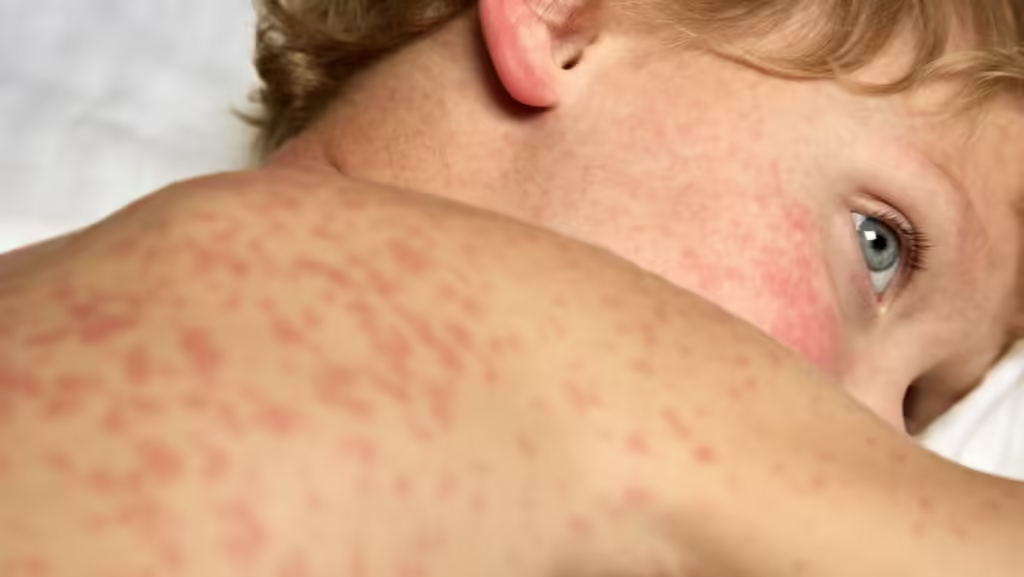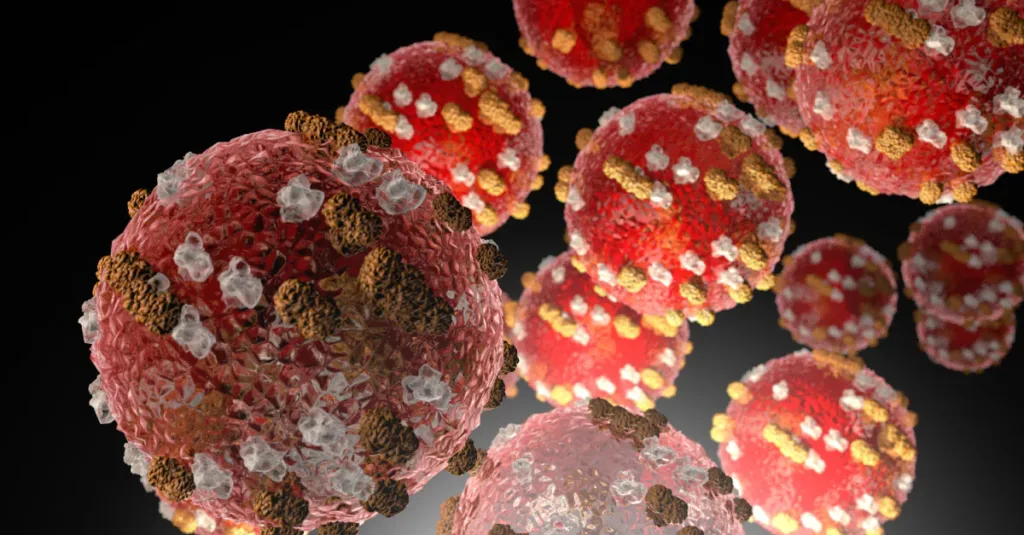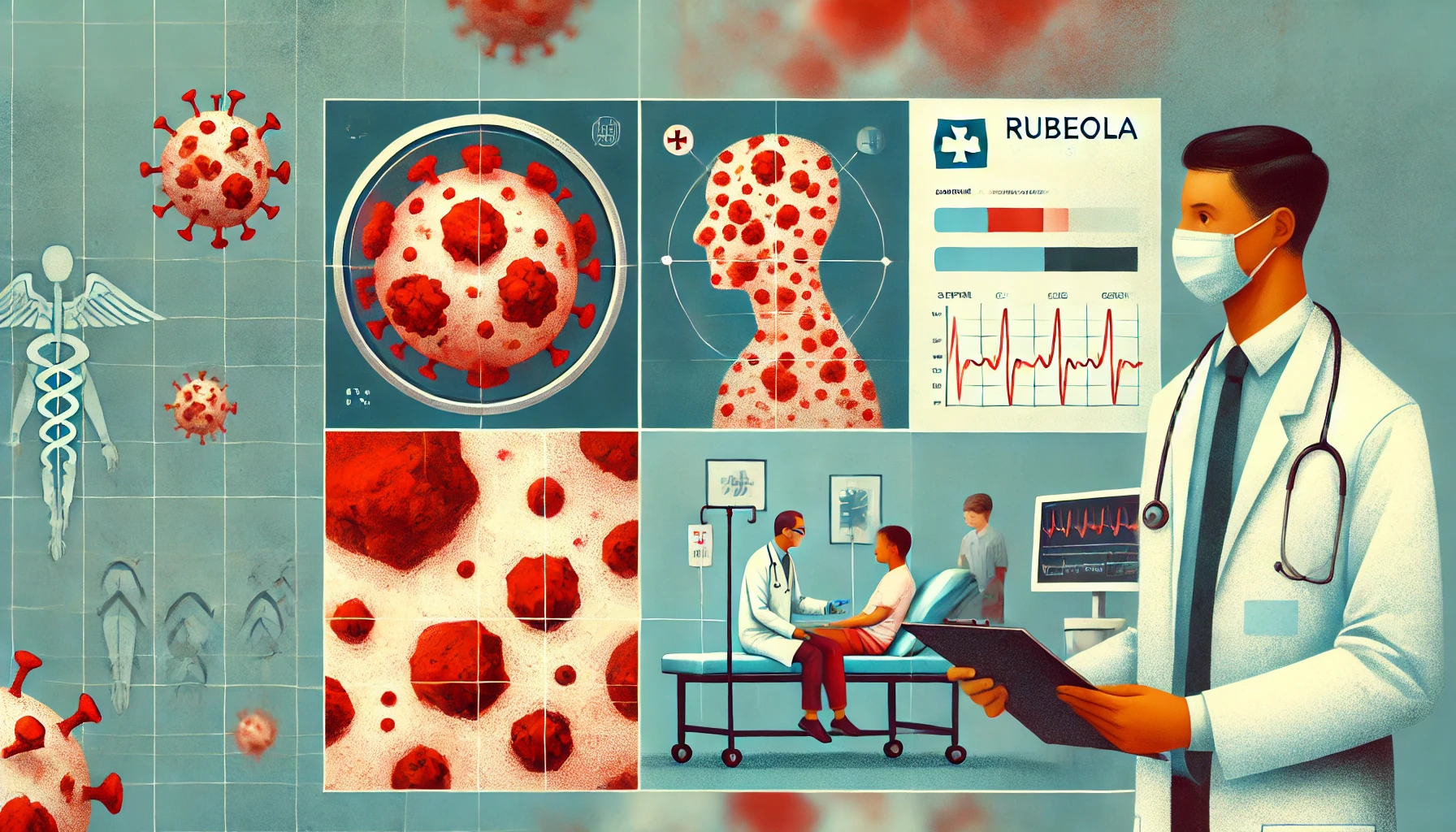Definition of Measles
Measles (Rubeola) is an acute infectious disease caused by the measles virus, affecting children and unvaccinated adults. Since morbilli is transmitted through the respiratory route, it can spread rapidly, leading to large outbreaks in communities lacking immunity. While most cases of measles are mild, complications such as pneumonia and encephalitis-meningitis can result in irreversible sequelae. In pregnant women, it can lead to miscarriage or preterm birth.
Etiology
The causative agent of morbilli is the rubeola virus, which belongs to the Paramyxoviridae family. The measles virus can be found in the throat, blood, and urine mucus at the end of the incubation period and for some time after the rash has appeared. The disease is most contagious during the prodromal phase (catarrhal stage) and decreases as the rash emerges.

The rubeola virus enters the human body through the respiratory mucosa or, in some cases, through the conjunctiva of the eyes. Therefore, Isolating the patient at home or in a healthcare facility is necessary to prevent the spread of the disease into an epidemic.
Symptoms of Measles
Rubeola progresses through four typical stages:
1. Incubation period
This period starts when the measles virus enters the patient’s body until the first symptom, usually a fever, appears. It lasts 8-21 days, with an average of 10 days. Adults tend to have a more extended incubation period than children.
2. Prodromal period (Catarrhal stage)
This stage, also known as the catarrhal stage, lasts 3-5 days. It is the most contagious period, characterized by the following main features:
- Fever: Initially, the fever is mild but quickly escalates to 39-40°C, accompanied by fatigue, general malaise, headache, and joint pain.
- Catarrhal symptoms: Common respiratory symptoms include a dry or productive cough, runny nose, and sneezing; conjunctivitis with tearing eye discharge; redness of the conjunctiva; and eyelid edema. Moreover, gastrointestinal symptoms may include diarrhea and mild abdominal pain.
The main signs of catarrhal symptoms are cough, runny nose, and conjunctivitis, with cough almost always present. - Internal rash: The throat mucosa may show minor white spots, the size of pinheads, raised on the buccal mucosa (inside the mouth, usually opposite the molars), often surrounded by erythema. This symptom is known as Koplik spots. The appearance of multiple Koplik spots can cause mouth pain and gingivitis, leading to poor appetite. Normally, Koplik spots typically disappear 24-72 hours after they appear and are a valuable early and definitive diagnostic sign of measles.
Furthermore, Lymph nodes may become swollen and tender.
3. Exanthem period (Rash stage)
The rash begins 4-6 days after the onset of the disease. The measles rash is non-blanching, maculopapular, slightly raised, with a smooth texture on palpation. The rash appears in a scattered pattern or coalesces into patches 3-6 mm in diameter. The rash spreads in a specific sequence:
- Firstly: The rash appears behind the ears and gradually spreads to the cheeks and neck.
- Secondly: The rash spreads to the chest, abdomen, and arms.
- Lastly: The rash spreads to the back, hips, and legs.

During the onset of the rash, body temperature rises to 39-40°C, and the patient feels more fatigued, with increased coughing, which can be dry or productive with white sputum.
After three days of rash, as the rash spreads over the entire body, the fever usually subsides, and systemic symptoms quickly diminish, with the patient feeling significantly better, though coughing may persist.
Close monitoring for severe complications is necessary if a high fever persists during this stage.
Additional symptoms may include swollen and painful lymph nodes, splenomegaly, abdominal pain, vomiting, and diarrhea.
Once the rash covers the entire body, it gradually fades in the order it appears.
4. Recovery period (Convalescent stage)
Typically, after six days of illness, the measles rash gradually fades in the same order it appeared, leaving behind dark spots with delicate, scaly peeling known as “tiger-striped skin.” This sign confirms the diagnosis of measles. These spots usually disappear within 7-10 days. The patient gradually recovers and regains appetite, and though coughing may persist, it will decrease over the next two weeks.
5. Other clinical forms
- Mild measles: Characterized by little or no fever, mild runny nose, and faint rash that fades quickly. Nevertheless, this form is easily missed or misdiagnosed, leading to community outbreaks.
- Severe (malignant) measles: Very rare, mainly in children. Severe signs include a high fever of 39-40°C, agitation, lethargy, convulsions, rapid pulse, hypotension, and a dense rash covering the entire body. Therefore, the prognosis is poor, with a high risk of mortality.
- Measles in adults: Generally more severe than in children, with more pronounced symptoms and a higher rate of complications.
- Rubeola during pregnancy: Although measles does not cause fetal deformities like rubella, it increases the risk of miscarriage and preterm birth.
- Measles in immunocompromised individuals: Patients with compromised immune systems contracting measles have a higher mortality risk. However, symptoms are often atypical, making diagnosis challenging.
- Measles and tuberculosis: Theoretically, measles can facilitate the reactivation of tuberculosis.
6. Complications of measles
Common complications include pneumonia, laryngotracheobronchitis, diarrhea, otitis media, stomatitis, and moreover, nosocomial infections.
Rare complications include encephalitis, myocarditis, pericarditis, and corneal ulcers or scleral ulcers.
Pneumonia and encephalitis are the leading causes of mortality in measles patients.
- Respiratory complications: Usually due to secondary bacterial infection, ranging from upper respiratory infections to interstitial pneumonia or Hecht pneumonia. Patients often have high fevers, even when the rash is widespread, with a severe cough and respiratory distress.
- Neurological complications: Encephalitis is the most dangerous complication of measles, presenting in three forms: acute encephalitis, acute disseminated encephalomyelitis, and subacute sclerosing panencephalitis.
- Gastrointestinal and ENT complications: Usually mild and non-life-threatening, such as pharyngitis, mesenteric lymphadenitis, and otitis media.
- Complications due to immunosuppression: Measles-induced immunosuppression can exacerbate opportunistic infections like tuberculosis and fungal infections.
- Ocular complications: Can result in permanent scarring or blindness, especially in individuals deficient in vitamin A or those with secondary infections by Pseudomonas spp. or staphylococci.
Diagnosis Measles
Diagnosis of measles is confirmed based on three factors: epidemiology, clinical features, and laboratory results.
1. Epidemiology: age group, ongoing rubeola outbreak, contact with a rubeola patient, and history of rubeola vaccination.
2. Clinical features: the following symptoms are considered:
- Viral infection syndrome: high fever, fatigue, general malaise, poor appetite, vomiting.
- Catarrhal syndrome: dry cough, productive cough, runny nose, conjunctivitis, diarrhea.
- Koplik spots
- Characteristic maculopapular rash: initially appearing behind the ears, then spreading to the face, neck, chest, abdomen, arms, and eventually the whole body. The rash disappears in the same order, leaving “tiger-striped skin” marks.
- Complications, if present.
3. Confirmatory laboratory tests: rarely used in clinical practice.
- Isolation of measles virus from blood or secretions
- Detection of Hecht giant cells
- ELISA test for measles-specific IgM
Differential diagnosis:
- Rubella: usually presents with milder symptoms, however, less respiratory and conjunctival involvement, smaller rash lesions, absence of Koplik spots, and “tiger-striped skin” marks.
- Exanthematous viral fever: lacks the characteristic rash sequence, no Koplik spots, and no tiger-striped skin marks.
- Allergic rash: rash does not follow a specific order, is often itchy, and appears following triggers such as food, medication, or contact exposure.
Treatment
Principles of Treatment
- There is no specific antiviral treatment for measles; therefore, management primarily involves symptomatic treatment and general supportive care.
- Patients with measles should be isolated to prevent the spread of the disease to the community.
- Early detection and management of complications are essential.
- Adequate nutrition and appropriate rest should be ensured.
- Outbreaks must be reported according to regulations.
Specific Treatment
- Antipyretics: Use tepid sponging and common antipyretics like Paracetamol; avoid Aspirin due to the risk of Reye’s syndrome.
- Nasal and throat hygiene: Avoid using medications containing corticosteroids.
- Cough management: Use Dextromethorphan for dry cough; Bromhexine, Acetylcysteine, or Ambroxol hydrochloride for productive cough.
- Nutrition: Provide nutritious and easily digestible food.
- Vitamin A supplementation: Administer as needed.
- Antibiotics: Use when necessary or in secondary bacterial infections, preferably beta-lactamase inhibitors or third-generation Cephalosporins.
- Nebulized Adrenaline: Administer if there is laryngeal edema or bronchospasm.
- Antihistamines: Use if necessary.
- Management of severe complications: Hospitalization for monitoring and treatment.
Isolation and Infection Control

- Use of surgical masks: For the patient, caregivers, close contacts, and healthcare workers.
- Limit unnecessary close contact Between healthcare workers, visitors, and the patient.
- Isolation period: From the onset of suspected measles until at least four days after the rash appears.
- Personal hygiene: Maintain nasal and throat hygiene, keep the body warm, and boost the immune system.
Prevention
- Immune response: Antibodies produced against measles after infection confer lifelong immunity, thus preventing reinfection.
- Passive immunity: Intramuscular injection of gamma globulin within six days post-exposure can provide emergency protection.
- Active immunization: Vaccination with a live attenuated measles virus provides high and long-lasting protection, lasting at least five years.
- Maintain a healthy lifestyle: Regularly exercise to boost the immune system.
- Preventive measures: Wear masks and protective eyewear, and avoid close contact with individuals showing respiratory infection symptoms.

